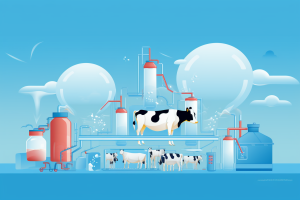‘It was the most difficult thing I’ve ever had to do.” That was the devastating confession of a British dairy farmer after selling his herd of cows, thereby ending a nearly 200-year-old family company.
What prompted this tragic decision? Within a few months, his milk price had dropped by 14p per litre, despite continuing high expenses for energy, animal feed, and fertilizers. “I’m not sure why anyone would want to continue,” he remarked.
The milk producer, who wishes to remain anonymous, related his experience to Sussex farmer David Exwood, who published the remarks on Twitter. His predicament is far from unusual. Dairy farmers and other food producers have been dealing with spiraling expenses since the commencement of conflict in Ukraine last February, which drove up energy expenditures, influencing the cost of fertilizer, which requires gas for manufacture.
Financial strains were increased further by last summer’s drought, which forced farmers to purchase extra animal feed due to a shortage of grass.
Due to milk shortages caused by the epidemic, wholesale prices reached all-time highs by late 2022, culminating at 51.6p per litre last December. Farmers could now breathe a sigh of relief since their bills had been met. But the reprieve was brief.
According to official data, the average farm-gate price for milk has been falling in recent months, falling to 37.6p per litre in May. This marked an almost 5% loss in a month, and a nearly 8% dip from the same month a year before.
Paul Rowbottom, a farmer who also sells animal feed, says he sees the effects of financial stress on the farms he visits in Staffordshire, Derbyshire, and Cheshire every day. “Trying to get money into the country is a nightmare,” he continues. “They can’t afford to pay their bills.” He claims that the dairy farmers and other food producers he serves are facing the most difficult circumstances he has faced in his 30 years in the business: “I don’t think I’ve ever seen so many people so irritated as now.”
Recent drops in milk prices have been ascribed in part to the “spring flush,” when cows naturally produce more milk when they are let out into fields, resulting in an overstock. However, dairy producers plainly believe that when milk processors and merchants cut the price paid for their product, they suffer financially.
Cheaper milk, as well as reduced costs for butter and bread, have lately been touted by supermarkets as they compete for price-conscious clients amid the cost of living crisis and a period of persistently high food inflation. A four-pint bottle currently costs £1.45 at supermarkets such as Tesco and Sainsbury’s, which is approximately 20p less than the price in early April and the lowest price since before the epidemic.
Food makers are also warning that a sustained flight of dairy farmers might jeopardize the UK’s existing liquid milk self-sufficiency. According to the National Farmers’ Union (NFU), over 5% of them quit the sector last year.
Andrew Hall, a farmer from Warwickshire, stands on a lush field, surrounded by cows.
Andrew Hall, a farmer in Warwickshire, claims that his children are unwilling to take over the family company. Photograph: provided
Following the price drop, the Dorset Dairy Company has become one of the latest farms to decide to sell off its milking cows. Dan Miller, the company’s operations manager, is the third generation in his family to manage a herd at Stalbridge. He now expects to sell their 180 cows in September, after which the firm will purchase milk from other sources to continue producing yoghurt, butter, and cream.
Miller claims he took the choice because to milk price instability, where the “happy days” of wholesale highs in late 2022 spurred many dairy producers to expand, just as consumers cut back on spending. People’s milk habits are also evolving, whether it’s a reduction in conventional cups of tea or morning cereal or the emergence of dairy-free alternatives.
Miller argues that the sector has been slow to adjust, with small suppliers being particularly susceptible. “With milk, you can’t easily turn off the taps,” Miller explains. “Many people said, ‘Let’s improve, grow, and produce more milk.'” We should have exercised greater caution.
“This is an epic cycle, and I don’t see it getting better quickly enough,” he said, explaining why he is selling his herd. “We don’t know how long this is going to last.”
Farmers throughout the nation are wondering how long they can survive in the face of mounting financial constraints and persistent labor shortages. In a recent study, over three-fifths of dairy farmers affiliated with Arla, the UK’s biggest dairy cooperative, expressed concern about labor shortages, stating it was more difficult to hire workers than in 2019.
Andrew Hall, a cattle and dairy farmer from Alveston in Warwickshire, has also had similar experience. The eldest two of his four children have already graduated from university and have opted not to take over the farm, while employees “my age and older are saying ‘I’m sick of this,'” he adds.
A hand clutching a plastic container with a pint of milk.
To cater to consumers suffering from the cost of living crisis, supermarkets have reduced the price of milk. Photo by Andy Rain/EPA
“I’m finding it difficult financially and mentally, and obviously labor is a huge issue,” he adds, adding that he’s getting 15p less per litre than he did in February. “The majority of dairy farmers work seven days a week, but this is 2023, not 1983 or 1973.” And we’ve been left behind in terms of pay.”
The 56-year-old will also miss his one week of vacation this year since his “relief milking” assistance is recuperating from a car accident. “I can’t find anybody else to milk,” he explains.
Hall has cut the quantity of grain supplied to his cows and is scaling down output to stay under his budget, glad that there is more grass available than last summer. “You never hear of farmers striking,” he observes. “But we have been taken advantage of for far too long.”
A big number of dairy cows are coming to market at Kivells, an agricultural and animal auction company, due to succession issues. Mark Davis, an auctioneer in Exeter, anticipates selling 1,500 dairy cows during the next month. “We are seeing a lot of sales come forward,” he adds. “The milk price and finances are bound to have an effect.”
Davis, who also works part-time on his brother’s family dairy farm, says the next generation’s unwillingness to take over family enterprises is also a factor. “The upcoming sales are generally due to retirement; a couple have been ill; in one, the farmer died and the family did not want to take it on.”
Michael Oakes on his Worcestershire farm. He’s standing in an indoor shed with livestock rows on each side.
Michael Oakes, who farms in Worcestershire, expects that a new regulation would make the supply chain more equitable. Photograph courtesy of Christopher Thomond/The Guardian
Some farmers are hoping that the government would implement new laws in the coming months, bringing greater stability to the dairy supply chain. According to the Department for Environment, Food, and Rural Affairs (Defra), the dairy code is designed to “ensure supply contracts in the dairy sector are fair and transparent, with farmers being paid a fair price for their produce.”
The laws are intended to enable farmers to contest processors’ pricing and to prevent contract modifications from being forced on producers without their approval, while also making it easier for them to express their concerns.
Michael Oakes, a dairy farmer in Worcestershire, is optimistic that the measures, which are due to become law in the fall, would “remove some unfair practice from the supply chain.” He feels that the present scenario, in which farmers often only learn out what they will be paid for next month’s milk a few days in advance, is unsustainable.
Oakes, who also serves as head of the NFU’s dairy board, expects that the restrictions would “create a new relationship with processors, getting rid of the ‘us and them’.” We rely on one another, but it’s never seemed like a real collaboration.”
For the time being, dairy farmers like Hall are dedicated to staying in farming, although admitting that he sometimes fantasizes about a life without caring for a dairy herd. “I could rent out farm buildings for storage and live a simpler and better lifestyle.”





 According to Rabobank’s annual Global Dairy Top 20 report, which highlights revenue performance of the world’s dairy sector leaders, just five businesses retained their place from the previous year, suggesting a rearrangement throughout the whole list. Lactalis maintained its lead, but Dairy Farmers of America moved up to second, pushing Nestlé to third. Position changes in the ranking were impacted by a higher US dollar. The aggregate turnover of the Top 20 corporations increased by 7.4% in US dollar terms, after a 9.3% increase the previous year. For these 20 market leaders, merger and acquisition activity was virtually on par with the previous year. The second half of 2022 had a slump, which lasted into the first part of 2023.
According to Rabobank’s annual Global Dairy Top 20 report, which highlights revenue performance of the world’s dairy sector leaders, just five businesses retained their place from the previous year, suggesting a rearrangement throughout the whole list. Lactalis maintained its lead, but Dairy Farmers of America moved up to second, pushing Nestlé to third. Position changes in the ranking were impacted by a higher US dollar. The aggregate turnover of the Top 20 corporations increased by 7.4% in US dollar terms, after a 9.3% increase the previous year. For these 20 market leaders, merger and acquisition activity was virtually on par with the previous year. The second half of 2022 had a slump, which lasted into the first part of 2023.

 100vw, 300px” data-lazy-src=”https://b9p2a4g2.rocketcdn.me/wp-content/uploads/2023/07/ETrucKing_dairy_cows_in_farm_field_long_shot_landscape_stoic_ci_04b84eb3-7f93-47b7-9aba-0f2a5cabd685-300×200.png”></p>
<p id=) The economic cost of dairy consolidation is a story filled with the incredibly orchestrated and devastating farmer loss and hardship, and a worsening environmental outlook.
The economic cost of dairy consolidation is a story filled with the incredibly orchestrated and devastating farmer loss and hardship, and a worsening environmental outlook. 100vw, 300px” data-lazy-src=”https://b9p2a4g2.rocketcdn.me/wp-content/uploads/2023/07/ETrucKing_dairy_cows_abstract_flat_minimalistic_428cd8b8-42af-472a-b2e2-eedd7632f965-300×200.png”></p>
<p id=) The urgent need for dairy policy reform is clear. The current state and federal dairy policies are driving family-scale farms to extinction while fueling the climate crisis.
The urgent need for dairy policy reform is clear. The current state and federal dairy policies are driving family-scale farms to extinction while fueling the climate crisis.






